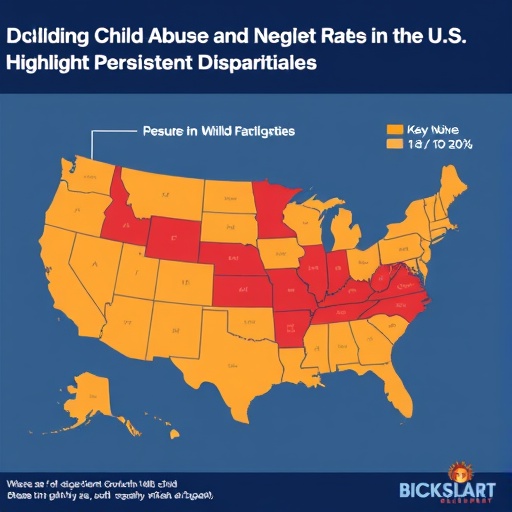A comprehensive study conducted by investigators at Mass General Brigham has unveiled important national trends regarding child abuse and neglect across the United States, revealing a complex landscape of progress intertwined with persistent disparities. This expansive research, covering the years 2012 through 2023, analyzed millions of Child Protective Services (CPS) cases to provide an unprecedented overview of confirmed and referred incidents of maltreatment, encompassing emotional abuse, physical abuse, sexual abuse, and neglect. Published in the prestigious journal JAMA Pediatrics, the findings underscore a critical societal issue, emphasizing the significant role poverty plays as a pervasive driver of child maltreatment.
Over the past decade, the data demonstrate an overall decline in confirmed reports of child abuse and neglect, signaling progress in protective interventions and policy effectiveness. However, these improvements are not uniformly experienced across all demographics, as the study meticulously disaggregated the data by race, ethnicity, and sex, uncovering alarming disparities that have either endured or, in some instances, widened. The nuanced insights derived from this whole-population study highlight the multifactorial challenges that complicate efforts to eliminate child maltreatment entirely.
Lead researcher Dr. Richard T. Liu, affiliated with Massachusetts General Hospital, articulates the insidious influence of poverty as a fundamental stressor permeating family environments. This socioeconomic strain often eclipses nurturing capacities, creating conditions where children are at increased risk for neglect and abuse. The research advocates that combating underlying poverty through targeted social programs and public policy reforms is essential to reducing disparities and safeguarding vulnerable populations.
The study’s exhaustive dataset includes over 7.3 million confirmed cases alongside nearly 33 million referrals reported to CPS nationally, encompassing a wide spectrum of maltreatment types. Notably, while most forms of confirmed abuse and neglect declined during the study period, sexual abuse remained resistant to significant reduction, calling for urgent, specialized interventions that address its unique dynamics. This finding challenges assumptions about uniform progress and underscores the need for diversified prevention strategies.
Ethnic and racial disparities in child maltreatment incidence emerged as a persistent theme. Asian, Native Hawaiian, and Pacific Islander children consistently exhibited the lowest rates of maltreatment, with confirmed cases declining from approximately 19 per 10,000 children in 2012 to 15 per 10,000 in 2023. Conversely, Black children experienced the highest incidence rates, with only a modest decline from about 119 to 110 per 10,000 over the same span. These statistics reveal entrenched inequities that reflect broader systemic issues, including economic disparity, differential access to support services, and structural bias.
Gender differences also permeated the dataset, with female children disproportionately affected by all forms of maltreatment, particularly sexual abuse. Alarmingly, the disparities by sex widened over the study period, pointing to significant gaps in both prevention and protective responses for girls. This gendered dimension calls for interdisciplinary efforts that integrate gender-sensitive approaches into child welfare policies and community programming.
Researchers emphasize the efficacy of social safety net expansions, including Medicaid and the Supplemental Nutrition Assistance Program (SNAP), as preventive measures that mitigate economic hardship and its associated risks. Empirical evidence correlating increased enrollment in these programs with reduced child maltreatment rates provides a compelling argument for policy makers to strengthen and expand public assistance programs. By alleviating poverty-induced stressors, such interventions create more supportive environments that enhance the wellbeing of at-risk families and children.
This study also tackles the complexity of referral practices to CPS. While confirmed cases have declined, referral rates have remained largely unchanged, suggesting potential shifts in reporting practices, investigative thresholds, or systemic responsiveness. This stability in referral volume alongside decreasing substantiations prompts further inquiry into child protection protocols and community-level awareness and engagement.
The methodological rigor of the study, leveraging a whole-population approach, allows for granular, nationally representative insights that surpass previous regional or sample-restricted analyses. By including an unprecedented volume of cases across multiple racial, ethnic, and sex strata, the researchers provide a robust evidentiary foundation to inform public health strategies and guide equitable policy development.
Furthermore, the study’s temporal span captures evolving social dynamics and policy environments, situating its findings within the context of broader socioeconomic shifts, health care reforms, and social justice movements. This longitudinal perspective is invaluable for understanding how systemic interventions and cultural shifts impact child maltreatment trends over time.
In conclusion, while the overall reduction in confirmed cases of child abuse and neglect offers a cautiously optimistic outlook, the stubborn persistence and magnitude of disparities demand focused, intersectional solutions. The intersection of poverty, race, ethnicity, and gender shapes the landscape of child maltreatment risk and resilience, and addressing these multifaceted challenges requires coordinated efforts spanning public health, social services, and legislative domains. This landmark study by Liu, Levin, and Turnamian serves as both a diagnostic tool and a clarion call for intensified, equity-focused intervention strategies to protect children and foster safer family environments across the United States.
Subject of Research: National Trends in Child Abuse and Neglect by Sex, Race, and Ethnicity in the U.S.
Article Title: A whole-population study of national trends in child abuse and neglect by sex, race, and ethnicity in the U.S.
News Publication Date: 10-Nov-2025
Web References:
https://jamanetwork.com/journals/jamapediatrics/fullarticle/10.1001/jamapediatrics.2025.4487
References:
Liu RT et al. “A whole-population study of national trends in child abuse and neglect by sex, race, and ethnicity in the U.S.” JAMA Pediatrics. DOI: 10.1001/jamapediatrics.2025.4487
Keywords: Poverty, Child Abuse, Child Neglect, Social Disparities, Public Health, Medicaid, SNAP, Child Protective Services, Gender Disparities, Racial Disparities, Epidemiology, Social Policy




